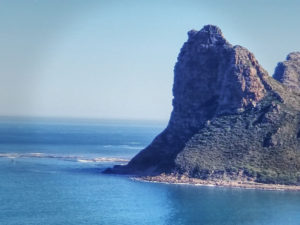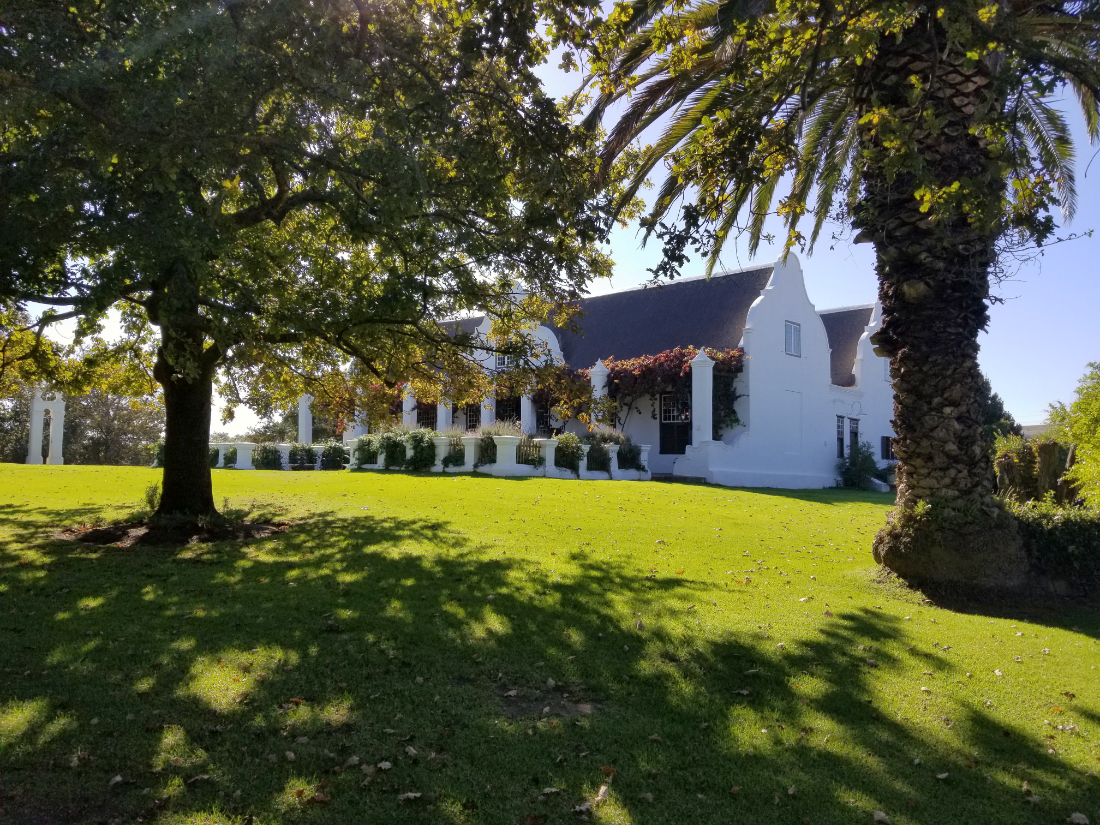My bride and I did not get much sleep, and not just because we were on our honeymoon. Hey, we were in Cape Town! Our morning began as we stood on our balcony looking out at Table Mountain. The flat mountaintop was covered with the usual morning clouds and fog, which the locals refer to as the “tablecloth.” Down below in the marina we saw two seals frolicking in the water. This was going to be an adventure!

Cape Town is in the midst of a severe drought, and water is rationed. We are requested to restrict our showers to 90 seconds. My immediate thought was of the drought’s effect on the wineries. Fortunately, the drought is limited to Cape Town. The surrounding area and the rest of the country are unaffected. However, Cape Town may be the canary in the coal mine, considering global warming. Other cities such as São Paulo, London, Moscow, and Beijing have been looking at Cape Town very closely, as they too are having water issues. Is Cape Town’s manner of coping with drought something that we will all have to look to in the future? It is an interesting thought for someone who lives in the desert.
Our guide, Ann-Marie Breen, met us after breakfast. Ann-Marie enjoys wine and provided an excellent insight into our South African wine adventure. Ann-Marie had selected the wineries and planned our itinerary. She quickly proved we were in good hands.
The vineyards, referred to colloquially as “farms” in South Africa, begin only 25 miles (40km) from Cape Town’s city center. Along the way, we passed several townships, which until the end of Apartheid, were reserved for non-whites, namely Africans, Indians, and Coloureds. The townships were usually built on the periphery of towns and cities in South Africa. The highways are quite modern, beautiful, and efficient, contrary to what is presented in Western media and propaganda. The countryside consists of rolling hills and valleys surrounded by high mountains.
Tasting in Stellenbosch
We soon arrived in Stellenbosch. Stellenbosch is, perhaps, the most well-known wine region in South Africa, and is South Africa’s second-oldest European settlement, after Cape Town. Stellenbosch’s reputation is based on making outstanding Chardonnay, Shiraz, and Pinotage. It also produces excellent Sauvignon Blancs as well as remarkable sparkling wines. Stellenbosch’s climate is similar to that of Bordeaux. Thus, we would soon discover the wines were of a similar style. Stellenbosch also has a wine route, like Napa, Sonoma, or many of the wine regions in the United States. In fact, its first wine route began in 1971. Today, Stellenbosch is home to nearly one-fifth of all the vines planted in South Africa. Stellenbosch is also notable as the birthplace of the Pinotage.
Our first wine farm was Meerlust Wine Estates. Meerlust Wine Estates is a farm that has been in the Myburgh family for eight generations, and they have produced world-class wines since 1756. In fact, it was put into use as a traditional farm in 1693. The word, “Meerlust”, means “pleasure of the sea,” which is appropriate as Stellenbosch is in the Western Cape’s coastal region and only five kilometers from False Bay. The farm is technically located fifteen kilometers south of Stellenbosch, but it is still considered a part of the Stellenbosch appellation. A tree-lined road leads to a beautiful white manor house, rose gardens, family cemetery, bird sanctuary, and most importantly, the wine cellar.
Meerlust Wines

The first wine we sampled was the Meerlust Estates 2017 Chardonnay (Platter’s Guide ★★★★★ and 90 points – Decanter magazine). This Chard was made with 100% Chardonnay grapes, 13.00% alcohol, transferred to 50.00% new tight grain Allier French Oak and 50.00% second fill 300-liter barrels for fermentation. “Toto, I don’t think we are in Kansas anymore!”
A yellow-green in color, the nose was rich with apple, pear, citrus, honey, and floral notes. On the palate, the wine was crisp and full-bodied. All of our senses were fixated on the citrus fruit flavors, with a hint of tangerine and grapefruit. It lacked the buttery flavor found too often in American Chardonnays. I could not identify a distinct taste. Try as I must, it eluded me. However, upon reading the tasting notes I readily recognized it to be oatmeal. This was definitely not a typical over-oaked California Chard. The finish was long and clean. My baptism into South African Chardonnays had begun!
I love a good Merlot, and this was a good Merlot. (Sorry, Miles.)

We next tasted the 2016 Meerlust Pinot Noir (Platter’s Guide ★★★★☆ and 93 points-James Suckling.com). It was a very deep purple in color. Made with 100.00% Pinot Noir grapes and 12.60% alcohol. Its nose was distinct with cherries, strawberries, and spices. The palate was vibrant with minerality, red fruit flavors, and fresh acidity. This Pinot is a complex and elegant wine with rampant tannins to finish. The 2016 was one of Meerlust’s earliest vintages. The wine was matured in 50.00% new Allier Hogshead and 50.00% second fill Hogshead for 11 months. This Pinot was young. I would love to try it again in three to five years.
The 2015 Meerlust Merlot followed the Pinot Noir. This wine contains 85.00% Merlot grape, 8.00% Cabernet Franc, and 7.00% Petit Verdot. This Merlot is remarkable! The maturation in 50.00% new Nevers French oak, 50.00% second fill Nevers for 16 months before bottling is pronounced. It has a deep, dark red color, with a distinct nose of chocolate, spice, licorice, and plum. The palate is generous with silky tannins. This Merlot is full-bodied, offering generous, ripe, pure Merlot fruit with refreshing acidity, structured with pronounced length and minerality.
I love a good Merlot, and this was a good Merlot. (Sorry, Miles.)

The 2014 Meerlust Cabernet Sauvignon is deep purple and matured for 21 months in French oak, of which 50.00% was new and 50.00% second-fill casks. The alcohol is 14.00%. On the nose, dark berries, sweet spices, bell pepper, red and black fruit, vanilla and oak spice. The palate is medium-bodied, densely packed with fruit and sleek tannins. This wine cried out to be paired with South African braai (barbeque).
Julius Caesar is supposed to have said “Alea iacta est,” meaning “The die is cast,” as he led his troops towards Rome in 49 BC. When he reached the Rubicon River, the border of the eternal city, he determined to cross it. Thereafter, the term, “crossing the Rubicon” would mark an irrevocable point in history. Caesar’s decision profoundly shifted the course of Roman history – there could be no turning back.
Crossing the Rubicon

Rubicon is the decisive name chosen for the Meerlust’s flagship wine. That decision profoundly shifted the course of Meerlust’s fortunes. Nico Myburgh, the father of Meerlust’s current owner, whilst holidaying in Bordeaux, discovered that the terroir in this area of France was similar to that of the Eerste River Valley in the Western Cape. Both regions have a distinctive climate, characterized by cooling sea breezes. Moreover, both regions have a soil structure made up of decomposed granite and clay. Nico returned to Meerlust, intent on creating a blend of his own that would rival those he enjoyed in France. This was the genesis of Rubicon.
The 2014 Rubicon (Platter’s Guide ★★★★☆ and 92 points – The Wine Advocate) is a blend of 61.00% Cabernet Sauvignon, 23.00% Merlot, 12.00% Cabernet Franc and 4.00% Petit Verdot, and it has a 14.00% alcohol content. The Rubicon is a wine that definitely has the “Wow factor!” Like Caesar, there could be no turning back. (Note: the link is to the newly-released 2015).
The nose is of dark fruit, cassis, plum, cigar, and licorice. It is very taut and has a subtle oaky spice aroma. On the palate, this wine is unrestrained, rampant with dark chocolate, flowers and fresh herbs, and hints of vanilla. The 2014 Rubicon is a wine that will withstand the test of time.
Stellenbosch is beautiful. Driving along the highway to the next wine farm reminds me of driving through Napa or Sonoma, except the highways are wider in South Africa. The hills and rows of vines are just as beautiful. Oh yes, there is just one other little difference. In Napa and Sonoma, you will see an occasional cow or sheep in a vineyard. Whilst in Stellenbosch driving we saw a kudu (the largest antelope in South Africa), a zebra, and an ostrich at some of the farms. Most disconcerting was a sign at Tokara Farm warning us to be aware of leopards! The upside was the sign said that leopards in the Western Cape are smaller than those in other parts of South Africa. Fortunately, we did not see one to measure the size.

Next – Incredible scenery, and Jordan and DeMorgonzon wineries.


